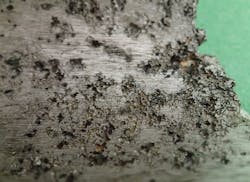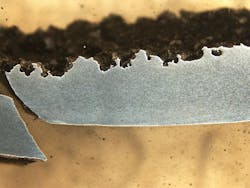Coiled tubing: Preventive maintenance and corrosion failure mitigation
Coiled tubing plays a critical role in the completion of oil and gas wells in the modern, unconventional oilfields of North America. The reliability and predictability of each string of coiled tubing is critical to continue providing safe, cost-effective completions support. However, corrosion in the field continues to be a challenge and to be properly mitigated, a thoughtful, preventive maintenance and corrosion mitigation program must be employed. This will enable coiled tubing to continue to be the preferred solution for conventional and unconventional oil and gas well completions.
What is coiled tubing?
Coiled tubing is a continuously produced length of steel pipe used primarily for intervention (service/workover) in oil and gas wells and delivered on large reels. Skelp end welds join shorter lengths of flat steel prior to forming into tube and welding longitudinally using a high-frequency induction welding process. Typically the lengths of continuously milled tubing, known as strings, vary in diameter from 1 to 3.5 inches and in length from 5,000 to 35,000 feet and have a nominal wall thickness of up to 0.250 inches. The ultimate tensile strength of coiled tubing can range from 80,000 to 140,000 psi. Coiled tubing is deployed downhole by plastically deforming the pipe off the reel, and recovering by reeling back on the reel. Each time it is deployed, it is plastically deformed, which accumulates fatigue and will eventually cause failure if not properly managed. The service duration of a string of coiled tubing is dictated by its low cycle fatigue life.
Importance of coiled tubing maintenance
Utilization of coiled tubing has dramatically increased in volume and intensity during the past six years of the shale (unconventional) play evolution. This evolution in utilization requires operators and manufacturers of coiled tubing to be increasingly vigilant with preventive measures to reduce the possibility of failures on the well site. Such failures of coiled tubing can result in health, safety and environmental damage. The value at stake can range from the coiled tubing string itself to substantially more.
Typical failure modes
Significant effort has been employed to understand the low cycle fatigue life of steel coiled tubing; However, localized degradation in the form of corrosion creates isolated wall loss within the string of tubing. While additional efforts have been undertaken to understand the residual fatigue life of a variety of damage and corrosion types, detection of an isolated area on the inside and/or outside diameter of an approximately 20,000-foot string of tubing is an onerous challenge.
Localized corrosion damage is one of the leading causes of premature failure (relative to predicted fatigue life) in the coiled tubing industry. Corrosion causes approximately 30 percent of premature retirements and failures. Corrosion prevention is critical to the predictability of coiled tubing.
Modes of failure from corrosion vary from storage corrosion to acid damage to microbiologically influenced corrosion (MIC). The last of these, MIC, continues to be the biggest challenge for North American operators.
Understanding corrosion & MIC
Corrosion of metal (steel) structures occurs in many industrial environments. Internal corrosion in particular may have different mechanisms and rates depending on the availability of dissolved oxygen in the service fluid. The rate is generally regulated by whether the environment is aerobic or anaerobic but either way is responsible for uniform corrosion. However, an accumulation of microbial populations along with the uniform corrosion results in localized pitting, which can grow rapidly and cause pinholes in the tubing. Image 1 depicts the localized corrosion damage that can occur due to MIC type corrosion cells within the base material and the skelp end weld.
When the coiled tubing is between jobs, fluid may be removed by nitrogen purge, but the residual fluid drains to the lowest wraps. Since oxygen is quite low, anaerobic bacteria such as sulfate-reducing bacteria (SRB) form a biofilm on the steel surface, resulting in MIC and localized pitting corrosion. Biological analysis of the fluid obtained from the corroded tubing has identified a dozen different types of bacterium populations.
Furthermore, the residual stresses in coiled tubing from reeling are near the yield strength of the material. It has been established that applied stress enhances corrosion of steels. Moreover, corrosion may occur preferentially at bias welds because of the local microstructural heterogeneity. Thus if the MIC-induced pitting corrosion occurs at the weld, the pit would grow much more rapidly. Also, the MIC is not necessarily associated with the welding zone. Tracks of corrosion and localized pitting in the base steel are present in many corrosion-related failures.
Image 2. After the formation of a biofilm, MIC can rapidly attack larger surface areas.
MIC basics
MIC is the deterioration of metals as a result of metabolic activities of various microorganisms in the environment. MIC is not a new corrosion mechanism, but the integration of the role of microorganisms in the corrosion process. Generally, microorganisms tend to attach themselves to a metal surface, colonize, proliferate and form biofilms, which produce an environment at the biofilm/metal interface radically different from the bulk medium in terms of pH, dissolved oxygen and solution chemistry. Because of the heterogeneity of biofilms, corrosion attack may start on the surface locally, usually in the form of pitting corrosion, as shown in Image 2. Even if corrosion occurs on the whole surface of a metal component, the corrosion rate under biofilms would be much faster than that at other areas. Thus, localized corrosion is always associated with the presence of microbes.
The environments to support MIC must contain water. Moreover, the microbial growth requires electron donors that are oxidized to release electrons (such as iron or organic matters), electron acceptors that are reduced to consume electrons (such as oxygen, SO42- and NO3-), energy (such as light or chemicals) and carbon sources (such as organic substances). Environmental factors that affect microbial population growth include temperature (usually less than 90oC), pressure (the upper limit is varied), water pH (not too acidic and not too alkaline), salinity (less than 7 percent by weight) and a certain range of redox potential.
No single mechanism exists for MIC. The MIC process depends strongly on the type of microbes and the environmental conditions. Furthermore, no single effective method exists for MIC detection. MIC identification is usually based on a comprehensive testing program that integrates biological testing, water chemistry analysis, corrosion morphology observation and corrosion product characterization.
Image 3. A polyurethane ball can be used to push the majority of fluids out of the string, and a brush pig can be used to mechanically clean the surface and rupture the biofilm prior to chemical treatment.
Present practices for integrity maintenance
Coiled tubing integrity maintenance has always been a priority in the industry but varies greatly by region because of different environments. Acid stimulations, continuous use, offshore applications and long-term storage demand different treatment programs. However, a large percentage of failures are still attributable to corrosion. In addition, the current practices for treating well fluids vary greatly by service company and oil company, and often they are reactive to failures in the field rather than proactive.
Generally, the industry emphasizes the use of batch treatment as the fluids arrive on-site or continuous treatment during operations. However, the consistency of the fluids, and cleanliness of the tanks and tanker trucks are often unreliable, as is the availability of chemicals for treatment. Therefore, a catch-all treatment program is difficult to monitor or maintain. In addition, post-job coil maintenance is the sole responsibility of the service company and is not a priority of the oil company. The emphasis at the end of the job is to move to the next completion operation; Therefore, extra time to pig and pump inhibitors or biocides is difficult to manage in addition to managing the resources to properly capture the coil maintenance fluids or pigs on-site.
The implementation of rigorous treatment programs has contributed to a reduction in corrosion-related failures in some regions. However, localized corrosive attack still accounts for some unpredictable failures in the field. Therefore, a more systematic and robust methodology is required to minimize the premature corrosion failures in the field.
Image 4. Biofilms can protect bacterial cells from fluid flow, allowing for rapid deterioration of the steel microstructure.
Recommendations for MIC control & preventive maintenance
Multiple options exist for treating MIC that need to be evaluated for performance, practicality and cost. The cost of a single corrosion-related failure far outweighs the initial costs of treatment. Therefore, it is critical to develop an appropriate and effective chemical treatment program that consistently deploys high-performance anticorrosion and antibacterium products for the actual service fluid, especially between jobs.
The chemical inhibitors’ anticorrosion and antibiodegradability properties should be highly compatible. Some biocides and inhibitors are not compatible and can counteract effectiveness, so compatibility is crucial. In addition, the importance of periodic “pigging” for dewatering and descaling of the tubing should not be underestimated. Even short periods of time during idle use should be addressed to minimize scale development. Image 3 shows a polyurethane ball that can be used to push the majority of fluids out of the string, and a brush pig can be used to mechanically clean the surface and rupture the biofilm prior to chemical treatment.
Treatment options include:
- Frequent tube purging of treated fluids using foam balls and nitrogen to ensure rigorous removal of all fluids, followed by inhibition for potential remaining fluid.
- Mechanical cleaning to descale the surface by means of brush-type pigs followed by chemically compatible biocides and inhibitors and a nitrogen purge.
- Pickling of inside surface followed by inhibitor slug and nitrogen purge. For this option, determining the appropriate fatigue derating factor for wall loss is critical.
Furthermore, the selection of materials and specific products conducive to or demonstrative of improved resistance to preferential corrosion is recommended. Quench and tempered coiled tubing has significantly improved microstructural homogeneity to resist such bacterial attack on the skelp end welds.
In summary, a significant knowledge gap in relation to the chemical treatment of fluid for coiled tubing operation and the successful long-term preservation of the facility has existed. This gap presents a high risk to operators’ key infrastructure developments and their multimillion-dollar investments. Using thoughtful preventive maintenance and corrosion mitigation measures presented in conjunction with optimized coiled tubing products are critical to the long-term reliability of coiled tubing in unconventional resource basins.
Alex Sheehan is vice president — sales operations for Global Tubing LLC. He holds a Bachelor of Science in Engineering from the University of Nebraska-Lincoln. After serving as a field engineer with a major oilfield service company, Sheehan served in several roles in coiled tubing manufacturing including technical sales engineer, product development engineer, engineering manager, vice president — service and customer support, and most recently, vice president — sales operations. Visit global-tubing.com or call 713-265-5000 for more information.






